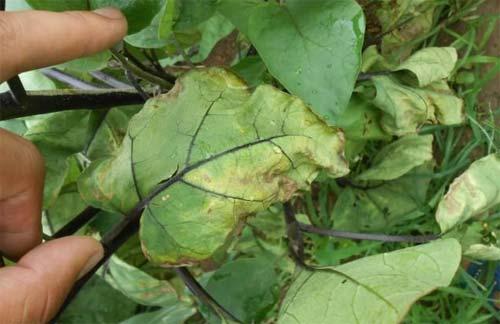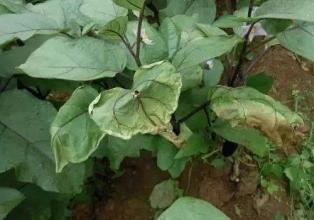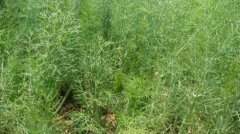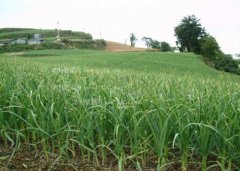Prevention and treatment of Verticillium wilt: what are the symptoms of eggplant Verticillium wilt? how to prevent and cure Verticillium wilt?
Verticillium wilt is one of the important diseases in the growth process of eggplant, and this disease is becoming more and more serious, and the aggravation of this disease also seriously affected the yield and quality of eggplant. Therefore, chemical control should be carried out according to the occurrence characteristics of the disease. How do you do it exactly? Let's take a look at it together.

I. occurrence regularity
Verticillium wilt of eggplant is caused by Mycobacterium tumefaciens. The pathogen overwintered in the soil with dormant hyphae, chlamydospores and microsclerotia and became the primary infection source in the following year. The bacteria in the soil can survive for 6 ~ 8 years, and the bacteria can be transmitted to the disease-free field by means of wind, rain, human, animal and agricultural tools through mixed fertilizer, bacteria-carrying soil and Solanaceae weeds. The optimum temperature of the pathogen was 19 ℃ ~ 24 ℃, and the mycelium and sclerotia died after 10 minutes at 60 ℃. Generally, the temperature is low, the root wound heals slowly during planting, which is beneficial to the invasion of bacteria; from planting to flowering, the daily average temperature is lower than 15 ℃ for a long time, the disease is early and severe, and the disease is serious in low-lying terrain, application of immature organic fertilizer, improper irrigation and continuous cropping land.
Second, symptom recognition
Eggplant Verticillium wilt can occur soon after eggplant is planted at low temperature, the disease is early and serious, but the disease area is the largest after fruit setting. When the disease is the most serious, the leaf edge of the lower half of the plant is yellow near the petiole and between the leaf veins. The leaf margin is slightly curled upward, and sometimes the disease spot is limited to half of the leaves, causing leaf distortion. In the early stage, the eggplant was wilted, which could recover sooner or later or after rain, and then the leaves turned brown, the whole plant wilted, the leaves were stripped and the whole plant died. When the disease develops rapidly, the whole leaves often turn yellow, turn brown and die. The disease is mostly caused by the whole plant. A few still have some healthy branches without disease. When the disease occurs, it develops gradually from the lower part of the plant, and in severe cases, the leaves of the whole plant fall off. The diseased plant is short, the plant shape is not stretched, the fruit is small, and the long fruit is sometimes curved. The vascular bundles of xylem were discolored and yellowish brown or brown were seen in the longitudinal section of the rhizome.

III. Prevention and control techniques
1. Soak the seeds before sowing. Soak seeds with 1000 times of 30% sterile EC for 5 hours before sowing
two。 Chemical treatment before transplanting. When transplanting eggplant seedlings, soak the seedlings with 2500 times of wet powder. If the seedlings are raised in a nutrition bowl, spray evenly with 2500 times of wet powder before transplanting.
3. Control at seedling stage. In the early stage of the disease, 2000 times of wet powder, 2000 times of bacteria aseptic EC and 1500 times of 10% germicidal superior water agent can be used alternately.
4. Result period of prevention and treatment. From the initial stage of the disease to the end of fruit picking, continuous spraying should be carried out at an interval of 7 days each time. Spraying with 5% disease absolute wettable powder 1500 times liquid, 10% germicidal excellent water agent 1000 times liquid, 12% chlorpromazine oil 1200 times liquid and so on. Foliar topdressing should be paid attention to in the prevention and treatment of Verticillium wilt. Adding 30 grams of potassium dihydrogen phosphate and 50 grams of urea to each sprayer bucket can enhance the stress resistance of crops and improve the quality of eggplant.
It is impossible for us to prevent the occurrence of this disease, but we need to know how to control and control the disease in order to ensure that the quality of eggplant will be better.
- Prev

Fennel planting method: how to grow cumin? What is the suitable temperature for cumin planting?
Cumin is the main developing cash crop in our state. Many people grow cumin, so how to grow it? Do you know? Next, we will start from the environmental requirements of cumin cultivation, the morphological characteristics of cumin and the cultivation requirements of cumin.
- Next

Garlic sprouts cultivation techniques: how to plant garlic sprouts? What are the main points of garlic seedling cultivation technology
Do you like garlic sprouts? Most people don't like it, only a small number of people like it, but garlic sprouts are still bought by many people, because it is a side dish that can add flavor, and we will put garlic sprouts in many dishes to add flavor. And that's what makes the more
Related
- Fuxing push coffee new agricultural production and marketing class: lack of small-scale processing plants
- Jujube rice field leisure farm deep ploughing Yilan for five years to create a space for organic food and play
- Nongyu Farm-A trial of organic papaya for brave women with advanced technology
- Four points for attention in the prevention and control of diseases and insect pests of edible fungi
- How to add nutrient solution to Edible Fungi
- Is there any good way to control edible fungus mites?
- Open Inoculation Technology of Edible Fungi
- Is there any clever way to use fertilizer for edible fungus in winter?
- What agents are used to kill the pathogens of edible fungi in the mushroom shed?
- Rapid drying of Edible Fungi

